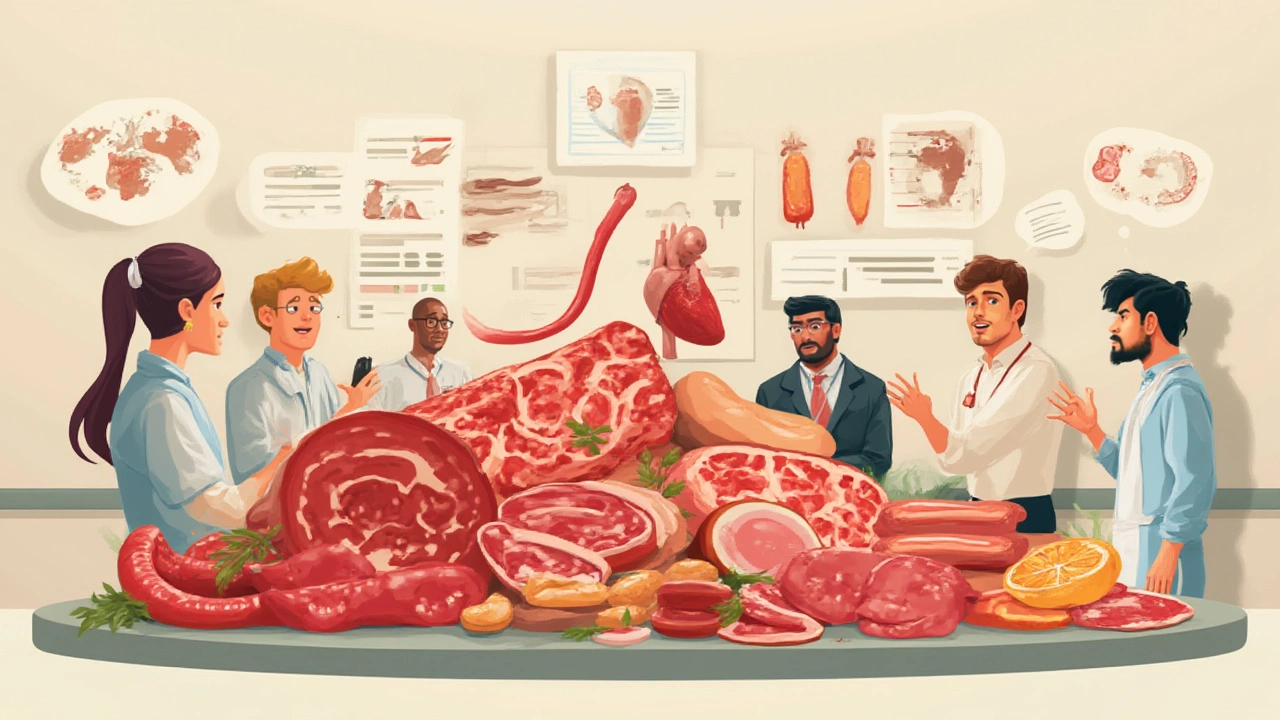Would you still order that burger if you knew what was in it? Meat is everywhere—in lunchboxes, on barbecues, sizzling in frying pans. But not all meats are equal, and some can pack a pretty nasty punch to your health. People toss around scary words like "carcinogen", "saturated fat," or "chemical preservatives." But what do they actually mean for your dinner plate? There's a lot more to the story than just "red meat is bad." The unhealthiest meat in your weekly lineup may not be what you expect, and picking safer options isn't always as simple as swapping steak for chicken. Let's dig into the facts and find out which meat is the real troublemaker in 2025, and what you can do about it—without giving up flavor or fun.
The Worst Offenders: Which Meats Are the Unhealthiest?
Walk into any supermarket, and the meat aisle might as well be a danger zone. Sure, steak can clog arteries and bacon has cholesterol, but the title of "unhealthiest meat" almost always lands smack in the middle of the processed meat family. Think: bacon, hot dogs, sausages, pepperoni, salami, and many cold cuts. The World Health Organization created a wave of panic back in 2015 when it classified processed meats as Group 1 carcinogens, right alongside tobacco and asbestos. Not the company you want your dinner sharing.
So, what exactly is a processed meat? In plain English: it’s any meat that’s been preserved by smoking, curing, salting, or adding chemical preservatives. This usually means unpleasant things like nitrates, nitrites, sodium, and sometimes even sugar. These meats don’t just show up at the deli counter—think of pepperoni on pizza, corned beef in sandwiches, or even those little cocktail sausages at a party. When these additives hit your gut, some of them can turn into nitrosamines, which are linked to colon and stomach cancers. According to a 2019 report in the journal Nutrition, eating just 50 grams of processed meat a day (about two strips of bacon) increases your risk of colorectal cancer by 18%.
Check out how some popular processed meats stack up in an average 100-gram serving:
| Meat Type | Calories | Saturated Fat (g) | Sodium (mg) | Preservatives |
|---|---|---|---|---|
| Bacon | 541 | 18 | 1717 | Nitrates |
| Pepperoni | 504 | 15 | 1582 | Nitrites |
| Salami | 407 | 13 | 1523 | Nitrites |
| Hot Dog | 290 | 8 | 1100 | Nitrites |
| Rotisserie Chicken (skin on) | 241 | 7 | 613 | Usually none |
Notice anything scary? All those numbers for sodium and saturated fat. That's before we bring cholesterol and chemical preservatives into the mix. Eating these meats day after day, even in "reasonable" lunches, can creep your risk of heart disease, diabetes, and even dementia higher. No need to panic over one slice of pepperoni—it's the regular, everyday eating that’s risky.
Red Meat: Is It Really That Bad?
Red meat has been getting grilled for decades by doctors and nutrition experts—nothing new there. Usually, we’re talking beef, lamb, and pork (yes, pork counts as red meat from a nutritionist’s point of view because of its myoglobin content). But is biting into a juicy burger or steak really the villain of your diet?
Researchers from Harvard followed over 120,000 people for more than 20 years. Their study, published in the Archives of Internal Medicine, found that eating red meat increased the risk of early death—especially from heart disease and cancer. It wasn’t the act of eating meat itself, though; it was eating processed or large quantities of red meat, often in place of healthier foods like beans, nuts, or fish.
Your grandma probably told you that steak "puts hair on your chest." Not untrue: red meat is packed with protein, iron, B12, and zinc. These are good things, especially if you have a heavy period or you’re an endurance athlete. The trouble starts with the stuff you don’t see—like saturated fat and cholesterol. High intake boosts LDL (bad) cholesterol and builds up plaque in your arteries. Also, grilling red meat at high heat forms chemicals called heterocyclic amines and polycyclic aromatic hydrocarbons, which can damage your cells.
Here's a quiz-worthy fact: pork and beef aren’t equals when it comes to risk. Pork sausage is much saltier and often processed, so it can cross over into the "unhealthiest" bracket faster. That’s why a slow-cooked beef stew is safer than a fried pork hot dog, even though both count as red meat. It’s about the way it’s prepared, too.
How much is too much? The American Heart Association suggests keeping red meat to 1-2 servings per week, and not supersizing portions. Think the size of a deck of cards. That means your triple-patty burger at a backyard barbecue packs way more risk than a few pieces of slow roasted Sunday beef (without slathered gravy or heaps of salt).

What About White Meat, Fish, and Alternatives?
Now you’re looking sideways at your chicken sandwich and wondering, "Is this secretly bad too?" White meats like chicken and turkey usually have much less saturated fat and salt. Roasted or grilled skinless chicken breast, for instance, is a lower risk option—one reason why bodybuilders and fitness influencers eat so much poultry. Unless you're buying deli “turkey” slices or fried chicken, these meats are hardly in the danger zone.
Fish is a different story. Oily fish like salmon, sardines, or mackerel are rich in omega-3 fatty acids, which actually lower your risk of heart attack and stroke. The Environmental Protection Agency does caution about mercury, especially for pregnant women, but the health benefits for most people usually outweigh the risks. Tuna salad has less saturated fat than ham, but watch the mayo if you care about calories.
For people going meatless, there’s tofu, tempeh, lentils, and beans. These aren’t technically “meat,” but they fill the same spot on your plate. Meat alternatives are usually low in saturated fat, have no cholesterol, and some pick up extra fiber. Not every plant-based burger is healthy—if it's deep fried or packed with sodium, you get some similar risks as with processed meats. But for the most part, plant-based proteins are a smart switch up.
Curious which meats get the nutritionist seal of approval as healthier options? Here’s a quick-fire list:
- Skinless turkey or chicken breast (baked, grilled, poached)
- Salmon, sardines, or trout
- Lean bison or game meats—often lower in saturated fat than beef
- Eggs—technically not a meat, but a classic protein source
- Lentils and beans for fiber, vitamins, and no cholesterol
Sneaky tip: Most of the flavor in fast food chicken comes from the deep fryer and salt, not the chicken itself. Try using spices like paprika, garlic powder, and a squeeze of lemon to level up baked chicken—Kiwi the parrot, my oddly judgmental kitchen companion, will beg for just about anything that smells like paprika.
How Does Cooking Method Change the Health Risks?
Picture this: two neighbors grill the same beef steak. One slathers it with barbecue sauce and leaves it to char, while the other sears quickly on low heat and adds herbs. The result? Not all grilled meats are created equal. The way you cook meat shakes up its health impact just as much as what you cook.
When meat cooks at high temperatures—think frying, open flames, or hot grills—it forms byproducts called advanced glycation end products (AGEs). These speed up aging and can make inflammation worse, especially in people with diabetes or heart disease. Another biggie: charred or blackened meat forms heterocyclic amines (HCAs) and polycyclic aromatic hydrocarbons (PAHs), both linked in animal studies to higher cancer risk. These chemicals don’t disappear when you scrape the burnt bits off, either.
If you love barbecue season, you don’t have to hang up the tongs just yet. Marinating your meat with vinegar, lemon juice, or olive oil cuts HCA formation by up to 90%. Flipping your steak more often helps, too. Simmering, poaching, slow-cooking, or pressure-cooking meat at lower temps keeps those nasty compounds low. Steam from a slow cooker doesn’t crisp up the skin (sorry, crispy duck fans), but it won’t make your dinner dangerous.
Smart swaps can lower risk. Baking salmon instead of broiling it, or making chili with beans and ground turkey instead of beef, can slash unhealthy fat and chemical byproducts. Luna, my dog, knows the real trick: park yourself under the slow cooker, because whatever drops is bound to be tender and accidently healthy.

Tips for Safer Meat Choices and Delicious Swaps
Yes, unhealthiest meat is usually processed and fatty red meats—think bacon, salami, pepperoni. But small changes can make your meals so much better for you, without losing all the bite. Here’s how to keep your plate happy and your heart even happier:
- Limit processed meats to once a week or less—save that bacon splurge for a true treat.
- Swap out fatty ground beef for plant-based or lean turkey alternatives in chili or pasta sauces.
- Grill less, poach more: use marinades with lemon, herbs, or vinegar and cook at lower temps.
- Load up on veggies as side dishes for meats, since fiber helps lower cholesterol effects.
- If you can’t live without deli meat, look for nitrate-free and lower sodium versions.
- Eggs, legumes, and fish make amazing substitutes if you want to skip meat now and then.
- Read labels—if you see more than five ingredients in your salami, it’s time to rethink your sandwich.
- For busy nights, slow cook or roast a big batch of chicken for lunch leftovers all week.
- If you love flavor, experiment! Smoked paprika or cumin adds tons of taste without risky stuff.
There’s no rule that you have to cut out all meat to eat healthy—just be mindful about how often you eat high-risk types, try better cooking methods, and sneak in other protein sources for balance. Listen to your body (and maybe a parrot or two)—they’re usually pretty blunt if something’s not right.
So the next time you’re eyeing up lunch, think for a second. Every small change adds up, and swapping salami for grilled chicken, or roast beef for a nice trout fillet, is one of the easiest wins for your health you’ll ever make.






